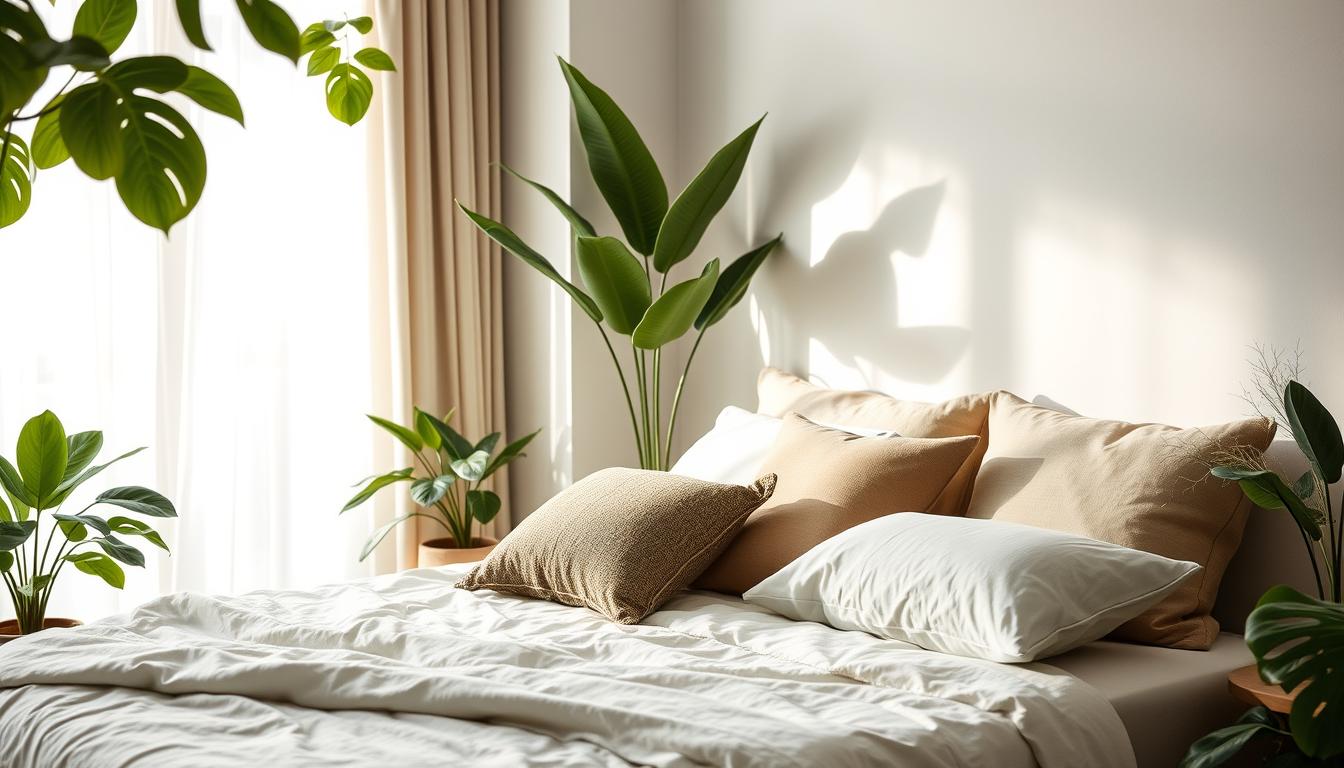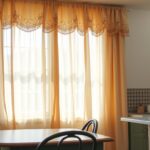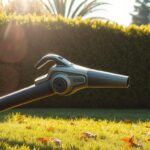When I go to bed, I feel safe and cozy. My bedding is like a special place for me to rest. But, there’s a big issue we all need to think about.
Our choices can help or hurt the planet. That’s why I choose eco-friendly bedding. It’s good for the earth and makes me feel better too. I want to pick sustainable bedding that’s kind to our planet.
Switching to environmentally friendly bedding is a big step. It’s not just for me, but for all of us. We can make a difference by choosing better materials.
Things like organic cotton and linen are great choices. They’re strong and gentle on the earth. More and more people are looking for these options.
There are new, green materials like TENCEL. It’s made in a way that’s good for the planet. It shows us that we can have nice things and be kind to the earth at the same time.
Key Takeaways
- Traditional bedding uses synthetic fabrics, which harm the environment.
- Sustainable bedding is better for the earth and makes us feel good.
- Plant-based fabrics and TENCEL are leading the way in eco-friendly bedding.
- Sustainable certifications help us trust that products are really eco-friendly.
- More people want bedding that’s good for the planet.
- Choosing eco-friendly bedding can really help reduce our carbon footprint.
Understanding the Importance of Sustainable Bedding
I care about the planet and our health. I’ve learned a lot about bedding. Non-toxic and eco-friendly bedding is key for a good sleep.
The Environmental Impact of Traditional Bedding Materials
Traditional bedding harms the planet. Polyester takes forever to break down. Cotton uses a lot of water and chemicals.
But, organic and plant-based materials are better. They use less water and no harmful chemicals.
Health and Wellness Benefits of Eco-friendly Bedding
Choosing non-toxic bedding is good for health. Organic cotton and linen don’t have bad chemicals. They’re soft and don’t make allergies worse.
Materials like TENCEL are also great. They’re soft, keep you cool, and are safe from germs.
The Role of Eco-friendly Bedding in Sustainable Living
Eco-friendly bedding fits well with living green. It helps make our homes better for the planet. It also shows we care about the environment.
By picking eco-friendly bedding, we help make the world a better place. We support good practices and help others do the same.
In short, eco-friendly bedding makes our lives better. It’s comfy, clean, and good for the planet. Now is the perfect time to make the switch.
Key Features of Sustainable Bedding Materials
I’ve learned that choosing bedding affects our health and the planet. Green bedding and natural bedding are more than trends. They are a choice for a better life. Let’s look at what makes bedding eco-friendly.
Biodegradability and Compostability
Sustainable bedding, like TENCEL™ fibers, breaks down easily. This means they don’t harm the environment when thrown away. It’s a big step towards living greener.
Organic Certifications Explained
Choosing natural bedding means knowing about organic certifications. The Global Organic Textile Standard (GOTS) ensures materials are safe and eco-friendly. It’s good for us and the planet.
Water Usage and Sustainability in Fabric Production
Brands like Jindal Ecotex use less water in making fabrics. This is important because old ways use a lot of water. They show us how to make bedding that’s good for the planet.
Knowing these features helps us pick better bedding. It’s not just about feeling good—it’s about caring for our planet. Choosing sustainable bedding is a step towards a greener future.
Eco-friendly Bedding: The Core of Our Discussion
Exploring eco-friendly bedding options shows how easy it is to mix sustainability with comfort. The sustainable bedroom is more than a trend. It’s a choice for better health and the planet. People now look for bedding that’s comfy and good for the earth.
More people are choosing mattresses made in the USA. These mattresses are eco-friendly. They use Bio-Pur® and HIVE® Technology for support. This makes a sustainable bedroom a complete idea.
| Feature | Details |
|---|---|
| Material Options | Bio-Pur®, HIVE® Technology |
| Pricing Range | $599 – $6000 |
| Sizes Available | Twin, Twin XL, Full, Queen, King, California King, Split King |
| Comfort Levels | Extra Firm, Firm, Medium, Plush, Ultra Plush |
| Height Profiles | 10, 12, 13, 14, 15, 16 inches |
| Warranty Period | 20 years |
| CertiPUR-US® Certification | Yes |
| Environmental Impact | Lower carbon footprint due to shorter transportation distances |
Choosing eco-friendly bedding means a sustainable bedroom for you and the planet. It’s a smart choice for our bedrooms.
Organic Cotton: A Popular Choice for Eco-Conscious Sleepers
Organic cotton is a big deal for those who care about the planet. It’s soft, comfy, and good for your health. That’s why it’s a top pick for green bedding.
The Benefits of Choosing Organic Cotton
Choosing organic cotton is more than just a cozy choice. It’s a way to help the environment. It’s soft and keeps you comfy all year round.
It’s grown without bad chemicals. This makes it safe for our skin and the planet. Plus, it keeps you cool at night, so you sleep better.
How Organic Cotton Contributes to a Healthier Ecosystem
Organic cotton is better for the earth than regular cotton. It uses 91% less water, saving our water. It also helps plants and soil, making the earth healthier.
Many people choose organic cotton for health reasons. They want to avoid harsh chemicals. This shows how safe and clean organic cotton is.
With climate change, choosing organic bedding is key. The organic cotton market is growing fast. More people want green, comfy bedding. Organic cotton is leading the way in eco-friendly sleep.
TENCEL: Revolutionizing the Bedding Industry with Eco-Innovation
TENCEL has changed the bedding market for the better. It’s made from wood pulp and is good for the planet. It’s soft, stylish, and eco-friendly.
Let’s look at how TENCEL compares to old fabrics. We’ll also dive into how it’s made. This will show why it’s so good for the environment.
Understanding the Production Process of TENCEL
TENCEL is made in a special way that saves water and solvents. Almost all of these are reused. It uses wood pulp from trees like eucalyptus.
This method is very green. It makes very little waste. It’s a big step forward for making fabrics.
Comparing the Environmental Impact: TENCEL vs. Traditional Fabrics
TENCEL is different from old fabrics like polyester and cotton. Polyester takes ages to break down. TENCEL breaks down fast and is good for the soil.
Cotton uses a lot of water and chemicals. TENCEL uses less water and is made in a cleaner way.
| Feature | TENCEL | Traditional Fabrics |
|---|---|---|
| Base Material | Sustainably sourced wood pulp | Petroleum, conventionally grown cotton |
| Environmental Impact | Low impact, fully biodegradable | High impact, slow to biodegrade |
| Production Process | Closed-loop, recycles 99% of solvents and water | Open-loop, significant waste and chemical runoff |
| Water Usage | Efficient, minimal | Excessive, particularlly in cotton production |
Choosing eco-friendly bedding materials like TENCEL is good for the planet. It also makes our bedding better. Bedding from sustainable fabrics is a smart choice for our health and the planet.
Linen: The Timeless Option with Modern Sustainability
Linen bedding is a top pick for those who love the earth and comfort. More people want eco-friendly things for their bedrooms. This is because they care about the planet and want to sleep well.
The Cultivation and Processing of Linen
Linen starts with the flax plant. It needs less water and pesticides than cotton. This makes growing flax better for the earth.
Flax makes linen strong and soft. It gets even softer with each wash. Linen uses less water and energy than other fabrics.
Why Linen is a Superior Choice for Allergen-Free Bedding
Linen is great for your health and the planet. It’s good for people with allergies because it’s hypoallergenic. It also keeps you cool and dry all year.
This makes linen bedding a top choice. People want it for its health benefits and because it’s good for the earth.
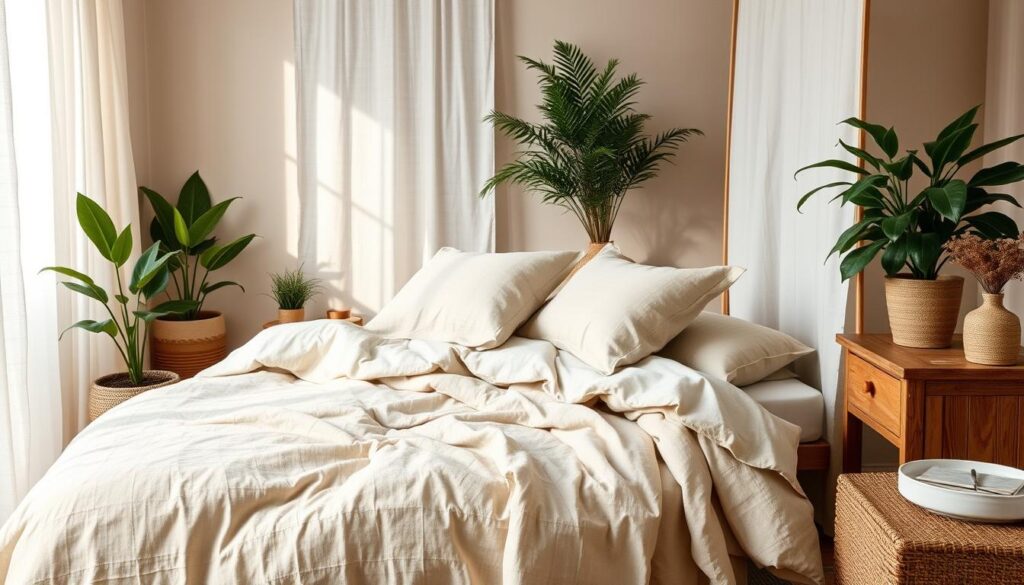
The table below shows why linen is better than other natural materials. It’s more sustainable and comfortable:
| Feature | Linen | Other Natural Materials |
|---|---|---|
| Water Usage | 90% less than cotton | Varies, generally higher |
| Pesticide Usage | Minimal | Higher in most cases |
| Durability | Extremely high | Moderate to high |
| Hypoallergenic Properties | Yes | Seldom |
| Moisture Wicking | Excellent | Varies |
| Environmental Footprint | Significantly low | Generally moderate |
Linen bedding is perfect for today’s eco-friendly lifestyle. It’s good for the planet and makes you feel great. So, linen is a top choice for those who care about the earth and their health.
Exploring Alternative Materials: Bamboo, Hemp, and Beyond
I’ve been looking for ways to live more sustainably. I found bedding made from bamboo and hemp. These materials are good for the planet and feel great on your skin.
Introduction to Bamboo as an Eco-Friendly Fabric
Bamboo is a big deal in eco-friendly fabrics. It needs little water and grows fast. This makes bamboo bedding a top choice for those who care about the planet.
Bamboo fabric is soft and cool. It’s perfect for hot weather or for people who sweat a lot at night.
Hemp Bedding: Combining Durability and Sustainability
Hemp bedding is also great. Hemp plants are strong and don’t need much water or chemicals. This makes hemp fabric last a long time.
Hemp and bamboo fabrics don’t grow bacteria. This is good for people with allergies or who don’t like synthetic materials. Switching to these fabrics is a smart choice.
I want to learn more about these materials. I’ll explore how they can make our lives better and our planet healthier. Every choice we make matters for the future.
How to Shop for Eco-Friendly Bedding: A Buyer’s Guide
Starting to shop for eco-friendly bedding can feel like a big task. There are many choices and things to think about. It’s important to know what makes bedding good for the planet. This includes the materials, how it’s made, and what happens to it when it’s no longer needed.
Deciphering Certifications and Labels
First, you need to understand the labels and certifications. Look for Global Organic Textile Standard (GOTS) and OEKO-TEX Standard 100. These show the product is safe and good for the environment. When I buy bedding, I check for these to know I’m helping the planet.
Understanding the Lifecycle of Sustainable Bedding
The lifecycle of bedding is key to its sustainability. It covers how it’s made, how long it lasts, and how it’s disposed of. The best bedding is made from materials that can break down or be recycled. This way, it doesn’t harm the environment.
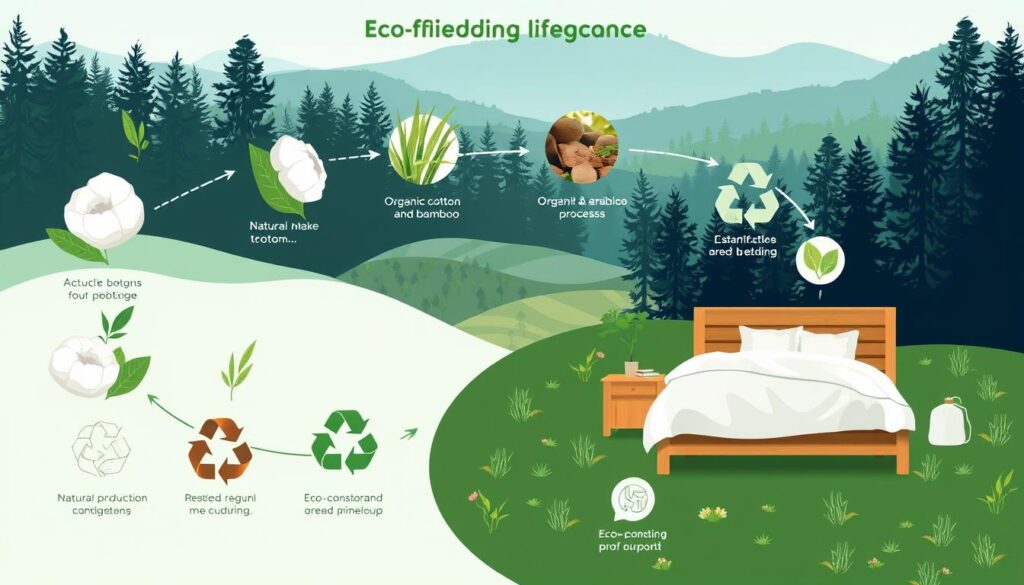
Shopping for eco-friendly bedding also means thinking about size, comfort, and cost. Here’s a table that compares different sheets. It helps you make a smart choice.
| Product | Dimensions | Price | Market Comparison | Thread Count |
|---|---|---|---|---|
| Queen Vintage Toile Sheet Set | 60” x 80” | $265.00 | $25-$250 more than alternatives | 140 |
| Basic Sheet Set | Multiple dimensions | $182.75 (Sales price) | Comparably priced | Variable |
| Crisp & Cool Organic Fitted Sheet | 40 cm high mattress fitting | £50.00 | 13-74% savings compared to other brands | 400 |
Knowing about certifications, the lifecycle, and practical details helps me choose well. I get bedding that’s good for the planet and comfortable. This way, I sleep well knowing I’m doing the right thing for our planet.
Conclusion
I’ve learned that eco-friendly bedding is more than looks. It shows I care about our planet. Organic cotton and TENCEL feel great and are good for the earth.
Hemp and bamboo are changing the game. They’re strong and gentle on our planet. This makes me feel good, just like my bedding.
Choosing eco-friendly bedding helps our world. It’s amazing how small changes can make a big difference. Like picking the right duvet size to save fabric.
My bedding shows I care about the future. It’s a small step towards a better world. I’m proud to be part of this movement.
The future of bedding is bright. We have more choices that are kind to our planet. My choices help make a difference.
By choosing eco-friendly bedding, I’m showing I care. My bedroom is a reflection of the world I want. It’s a place where every product is made with love for the earth.

